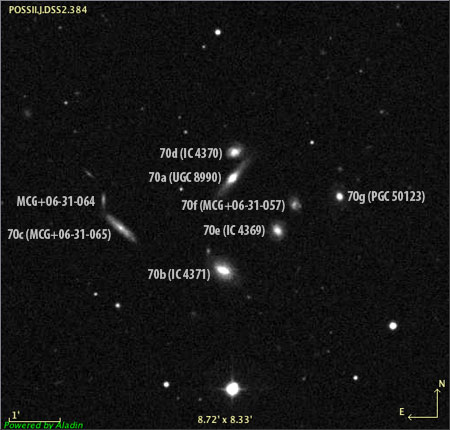If you are a galaxy cluster chaser, you’ve probably been rummaging through the Hickson clusters on a regular basis. I am not a seasoned Hickson observer–not even close. The only one I’ve tracked down is Hickson 92: Stephan’s Quintet…and even then, I wasn’t able to see all 5 members.
An interesting thing you’ll find about the individual galaxies within these clusters is that determining their official designations can sometimes get tricky. Hickson 92 is a relatively bright and well-travelled cluster, and each of its members has an NGC designation. However, other galaxy clusters contain members that are not catalogued with an NGC or IC number. These fainter galaxies need to be referenced by other catalogues, such as PGC, MCG or UGC.
| MCG – Morphological Catalog of Galaxies |
| Details: HyperSky MCG Details |
| Contains 30,642 galaxies. Based on examination of copy prints of Palomar Sky Survey plates down to 15th magnitude. (increasing limit to 16th magnitude was not possible because increase in number of galaxies would be “catastrophic” according to the authors.) ID takes form of AA-BB-CCC. AA = Palomar Survey declination zone (+15 = North pole, 0 = equator, -7 = -42°) BB = Field survey zone (60 divisions at equator, less divisions further from equator) CCC = Arbitrary ID for each galaxy within the AA-BB field |
| PGC – Principal Galaxy Catalog |
| Details: NASA HEASARC PGC Details |
| Cotains about 1 million galaxies. Consists of confirmed galaxies brighter than b-magnitude 18. Data contains precise (±2 arcsec) coordinates, diameters, axis-ratios, and position angles. (Based on HYPERLEDA database after 2003–was LEDA prior to 2003) |
| UGC – Uppsala Galaxy Catalog |
| HyperSky UGC Details |
| Contains nearly 13,000 galaxies. Based on Palomar Sky Survey. Designed to be complete down to a diameter of 1 arc minute or magnitude of 14.5 on blue plates. |
Because the individual galaxies in these clusters can be so tightly packed and there are so many of them in total, there are times when their identities get swapped or duplicated–even in the most reliable online databases and software.
When preparing the April 29, 2008, post for ASOD, I was trying to apply labels to the seven galaxies visible in Bill Ferris’ excellent drawing of Hickson 70. When I got to the galaxy on the east side of the cluster known simply as Hickson 70c, there was a discrepancy in its MCG designation. Several lists at Vizier pointed to a designation of MCG+06-31-065. However, the data at NED that Bill kindly pointed me to, listed the galaxy as MCG+06-31-064. Not a big deal right? Yeah, probably not. But if you’re trying to prepare a resource for others to use, and if you’re a little bit pedantic, it’s hard to let go of a nagging inconsistency once it catches your eye. I’m not an expert at mining these deep databases, so I figured I was probably doing something wrong.
Because Brian Skiff is amazing at being able to see what’s going on with problems like this, I fired off an email asking for his thoughts. In less than 45 minutes, I had a reply email–he had pulled out a copy of the MCG prints, and found that indeed, the NED database had incorrectly assigned MCG+06-31-064 to that galaxy, and that it should actually be MCG+06-31-065. As several of the Vizier lists had indicated, the 064 galaxy actually referred to a smaller, fainter galaxy dangling off the northeast edge of its larger, brighter neighbor. Brian fired off a correction notice to the NED administrator, and I was able to re-label Bill’s image at ASOD.
Here is a DSS image showing the cluster, and the two galaxies that got confused (see the left–east–side of the cluster). If you’re a faint galaxy hunter, you know there’s nothing unusual about this. With databases containing tens of thousands of entries, swapped IDs and typos are a digital fact of life. It’s a great big universe out there.

Image provided by Aladin Sky Atlas